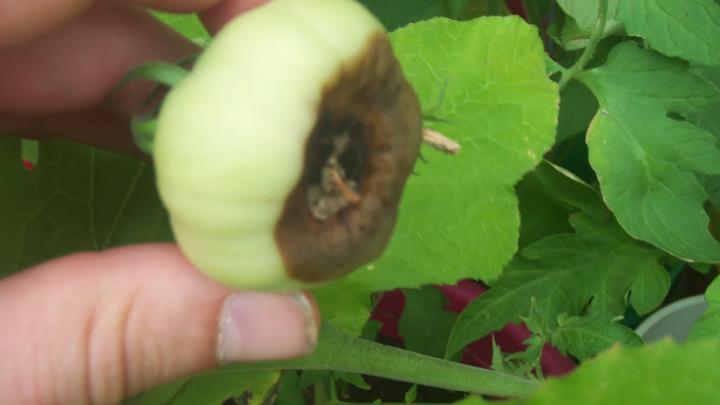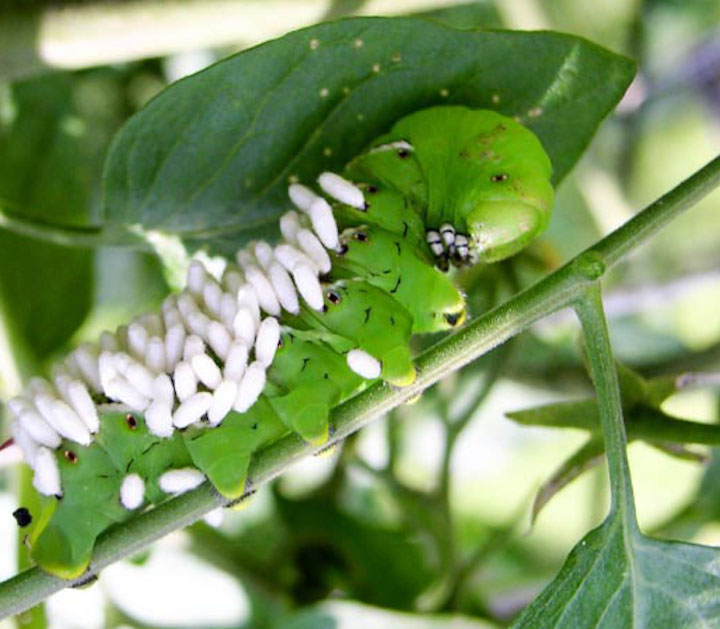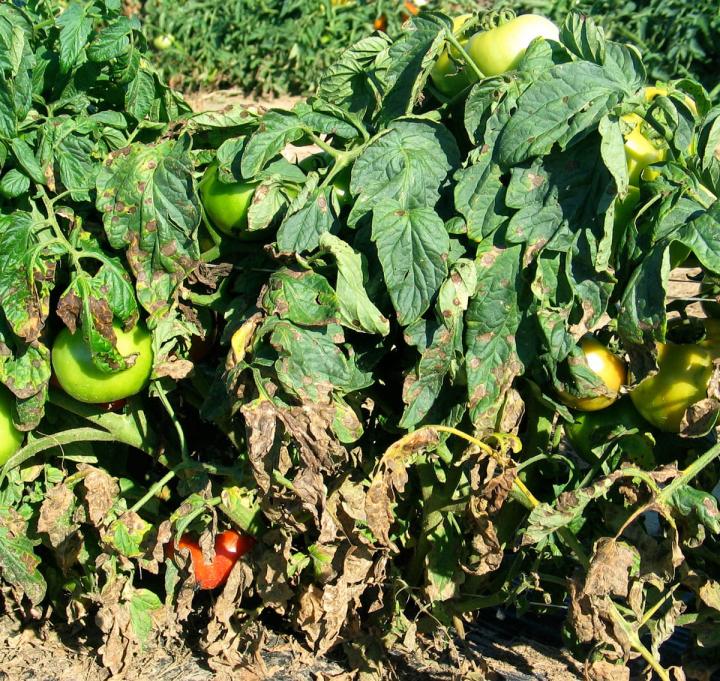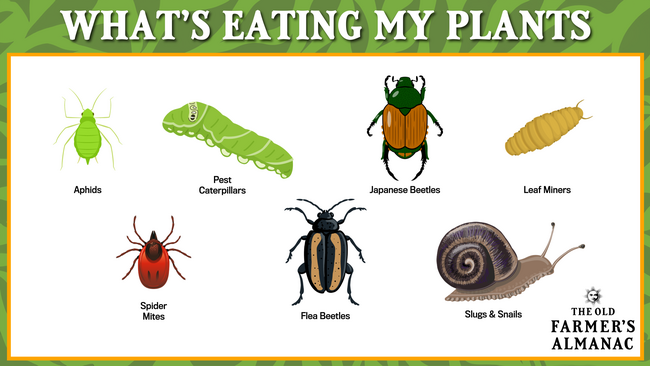Why Tomato Plant Leaves Turn Yellow and Other Problems
Do you have yellow leaves on your tomato plants? Do your tomatoes often start to crack? Are pests feasting on your tomato crop? Read about the top 10 tomato problems and their solutions (and watch our video, too). Keep your homegrown tomatoes healthy!
Top 10 Tomato Problems and Solutions
Blossom-End Rot
What is it? Blossom-end rot causes sunken black patches at the blossom end of tomato fruits. It is a common disease caused by dry soil conditions that result in a shortage of calcium in the plants. Plants in containers are particularly susceptible. This is caused by uneven watering (wet-dry cycles in soil) and too much nitrogen.
Solutions: Never let your soil dry out! Tomatoes are unforgiving. Going from dry to wet and back again creates problems like blossom end rot. Keep soil consistently moist; using mulch helps. For a quick fix, treat plants with a calcium spray. Feed your tomatoes regularly with a liquid tomato fertilizer. Test soil when tomato harvest ends. Amend soil as needed.
You can eat tomatoes with blossom-end rot—just cut the bottoms off. Learn more about Blossom-End Rot.

Cracks in Fruit
What is it? Tomato fruits crack or split when the soil gets too dry and then is watered heavily while the tomato is ripening. This causes the fruits to swell faster than the skins surrounding them.
This happens when watering or a heavy downpour follows a drought, sending so much water to the plant that the fruit pops out of its skin! The way to avoid this is to keep the soil consistently moist. Don’t let it alternate between too dry and too wet. It’s a spoiler.
Solutions: Keep your soil evenly moist. Prevent the condition by mulching soil and watering tomatoes deeply twice a week instead of giving plants a little water every day. When heavy rainfall is in the forecast, pick tomatoes that are almost fully colored. Cracked fruit is edible, but the cracks are more susceptible to mold. Eat ripe, cracked tomatoes before ones with smooth skins.
Aphids and Whitefly
What is it? Aphids and whiteflies are tiny sap-sucking insects that can appear on plants in large numbers. Some types transmit plant diseases.
Solutions: Blast off small infestations with a jet of water, or spray plants (including leaf undersides) with a soapy water solution. Plant flowers, for instance, marigolds, close to your tomatoes. These will help attract aphid and whitefly predators such as ladybugs and hoverflies. If necessary, you can buy these predators to introduce into enclosed environments such as a greenhouse or hoop house.
Spider Mites
What are they? Spider mites are tiny mites that thrive in warm, dry conditions. They can quickly weaken plants. Keep an eye out for their faint webs. Take a closer look, and you might see the tiny, usually red, mites.
Solutions: To avoid problems, don’t let your tomatoes dry out. If spider mites do attack, spray the plant all over with a fine mist of water. Drape the plant with a row cover for a few days to create the shady, humid conditions that the mites dislike.
Tomato Hornworm
What is it? The tomato hornworm is a caterpillar that chews holes in tomato fruits.
Solutions: Check your plants regularly for signs of damage, and remove and destroy any hornworms you find. You may find hornworms with little white cocoons on them. This is great news, and they belong to the larvae of braconid wasps, which feed on hornworms and help bring them under control.
See our Tomato Hornworm page for more tips.

Blight
Early blight, a fungal disease, is very common, especially in July when humidity is high. It usually begins on the lower leaves as brown spots that enlarge into concentric rings like a bull’s-eye. Eventually, they get bigger and run together, and the lower leaves turn yellow.
Solution: Stripping off the lower leaves as the fruits develop. Make sure the ripening tomatoes have maximum exposure to the sun. Provide plenty of space for the plants. Copper and/or sulfur sprays and the biofungicide Serenade can slow or prevent further development of the fungus on remaining plants.

Late Blight
What is it? Blight is a fatal plant disease that occurs during spells of warm, wet weather. Brown blotches show first on tomato leaves and stems, then on the fruits. Eventually, the plant will wilt and collapse. Late blight also affects potatoes, which are related to tomatoes.
Solutions: This is terminal. Remove and destroy blight-infected plants as soon as you see signs of the disease. If your plants have suffered from blight in the past, try growing them under cover if possible—it’s rarely a problem with indoor tomatoes.
When watering, take care to avoid splashing the leaves. While it’s hard not to wet the leaves a little while watering, water at the soil level. Try watering in the morning so leaves have time to dry during the day, minimizing the risk of plant disease.
Magnesium Deficiency
What is it? Magnesium deficiency is the most common mineral deficiency in tomatoes. It often occurs as a result of high potassium levels.
Solutions: Spray a solution of Epsom salts directly onto the leaves, then start using a tomato fertilizer that contains a higher proportion of magnesium.
Yellowing Leaves
The most common reason for yellow leaves is lack of nitrogen. You need to feed your tomatoes more! Tomatoes are heavy feeders, requiring twice the nitrogen as cucumbers and four times as green beans.
Potassium deficiency is less common; this will show up as bright yellow leaf margins (edges) instead of yellowed leaves. Lack of iron is only an issue on younger leaves. Low magnesium shows up as interveinal yellowing on older leaves. All can be addressed with fertilizer.
Solutions: Use a nitrogen-heavy fertilizer and follow the instructions. Also, pay close attention to watering. With the use of a lot of fertilizer, the plant will also require a lot of water. To test moisture, put your finger several inches deep in the soil; if it feels dry, water thoroughly. Get a moisture meter to keep tomatoes consistently watered.
Tomato Flowers Drop
If you see the flowers dropping, the weather may be too hot. If temperatures are consistently up to 85°F to 90°F (or above) and nights stay above 75°F, tomato flower pollen becomes unviable. Until the hot spell passes, keep plants well-watered and fertilized. Another option is to grow heat-tolerant varieties, like ‘Heatmaster’, ‘Homestead’, ‘Solar Fire’, and ‘Summer Set’.
Poor Fruit Set
What is it? Poor fruit set, when flowers fail to produce fruits, has a variety of causes, such as poor pollination, too much heat, poor nutrition, and very dry or very humid air.
Solutions: Open greenhouse and hoop house doors every day (weather permitting) to ventilate and allow access for pollinating insects, such as bees. Pollination can be enhanced by tapping on supports to dislodge the pollen or by gently twiddling the flowers between your fingers. If your climate’s very dry, raise the humidity around plants with regular watering. And make sure to feed your plants regularly with a store-bought tomato fertilizer or a homemade high-potassium liquid fertilizer such as comfrey tea.
Holes in Tomatoes
This is not a common issue, but we have had questions about small holes in tomatoes. This is caused by slugs because your fruit may be on the ground or hanging low. They can also crawl up tomato vines and supports, so keep an eye on your tomatoes and use slug treatments to kill adult slugs before they lay eggs. You don’t want holes in the tomatoes because it opens up wounds and entry points for many other bugs and diseases.
Half-Eaten Tomatoes
If your tomatoes are partially eaten, you have a critter! Often, we’re talking about squirrels or chipmunks, and they’re often after the water in the fruit. You could wrap your tomatoes in plastic bird netting clipped to tomato supports. You could also provide a water bowl or birdbath to ensure the wildlife gets its water elsewhere.
- Here’s more information about tomato diseases and disorders.
- See our Tomato Grow Guide for more pest information.
- Try our Almanac Vegetable Garden Planner to grow your most successful garden!
Very few plants thrive in soil that is always moist, so that may be part of the problem. You may be drowning the plant. It could be bacterial spot, which is prevalent during wet seasons (you see the connection?). It could be a blight, which is a soil-based fungi, but it's more likely water related. Water less often, e.g., when the soil is dry, and see what happens. Impossible to know if the plants will survive.
- « Previous
- 1
- 2
- …
- 10
- Next »









